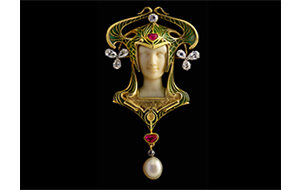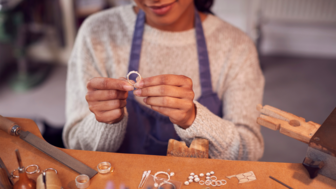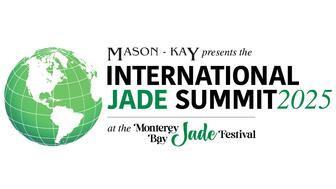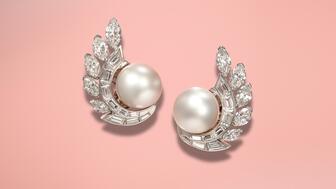These earrings by Van Cleef & Arpels, featuring the same design as a pair worn by Princess Grace, are up for auction at Woolley & Wallis.
The History Behind … Art Nouveau jewelry
The latest installment in National Jeweler’s antique and estate jewelry series examines Art Nouveau jewelry, which was created in France between 1895 and 1910.
New York--It was a short-lived period of design that focused on women and nature and was worn by only select members of society.
It was Art Nouveau jewelry, created in France in the late 1800 and early 1900s, a time before the first World War, when mass manufacturing got its start and the absinthe was flowing.
Recently, Elyse Zorn Karlin, co-director of the Association for the Study of Jewelry and Related Arts, walked National Jeweler through this fascinating, but short-lived, period in jewelry design.
When and where was Art Nouveau jewelry popular? Art Nouveau (“new art”) jewelry was created in France between about 1895 and 1910, coming on the heels of the “overwrought” designs of the Victorian era (which ended with Queen Victoria’s death in 1901) and creating a striking contrast to the mainstream Edwardian designs of that time, Karlin said.
While jewelry with a similar aesthetic was being made in other countries during the same time period--for example, Jungenstil in Germany and Austria--true Art Nouveau jewelry is decidedly French.
It was a short-lived period in jewelry design, lasting only about 15 years, because of the onset of World War I and because the pieces were so over-the-top that people quickly lost interest in them.
Why was Art Nouveau jewelry created? Like all art, the zeitgeist of a particular era is written in the design of its jewelry.
Karlin said Art Nouveau jewelry was a reaction to a number of things going on in French society at that time, including women’s fight to secure more rights for themselves outside of the home by getting an education and a job.
The French in particular seemed to have an “inordinate” fear of what would happen to their society if women won the equal rights they were fighting for, she said.
This was due in part to the nation’s loss in the Franco-Prussian War, which was hugely humiliating and left France feeling vulnerable. The idea of women leaving to work outside the home stoked fears of the birth rate dropping, leaving the country without enough men to support future armies.
This is why, Karlin said, so much of Art Nouveau is woman-centric.
The pieces depict a lovely, unthreatening woman with flowing hair and a sweet face; “fantasy” women, such as sexualized
In addition to women, Art Nouveau jewelry incorporated nature in a way that never had been done in jewelry before, with insects and flowers that had a sexualized nature to them.
“All of this was totally new for jewelry. There had never been anything like this before,” she said.
Who wore this jewelry? “There’s no doubt Art Nouveau was meant for a very select sample of society,” Karlin said.
The pieces were large and “in-your-face” and a lot of them depicted naked women, which was shocking at the time.
It also was expensive, so most pieces were donned by wealthy, artistic types.
Demimonde, unmarried women who were supported by wealthy lovers and considered to be on the fringes of acceptable society, wore Art Nouveau jewelry as did a number of well-known entertainers.
Karlin said probably the most recognizable was actress Sarah Bernhardt, who helped to make jewelry designer René Lalique famous. “If she didn’t wear Lalique jewelry, I don’t think it would have become known like it was,” she said.
What materials were used for Art Nouveau jewelry? While this certainly cannot be said for other periods, for Art Nouveau jewelry “The materials were not as important as the design,” Karlin said.
The pieces were less about gemstones and more about enamel, including plique-à-jour enamel. French for “letting in daylight,” plique-à-jour enamel is translucent, meaning it allows light to pass through; think of a stained-glass window.
Horn, usually from domestic animals such as cows, was heated and bent into different shapes for Art Nouveau pieces, and a lot of carved ivory was used as well.
Diamonds were used too, but mostly as accent stones.
How much is Art Nouveau jewelry worth today? Because much of it was made of enamel, which breaks easily, and it was a short-lived period in jewelry design, Art Nouveau designs in good condition are not abundant.
This, of course, also makes them highly desirable.
Karlin said while Art Nouveau pieces haven’t gotten up to the million-dollar range yet, pieces that are attractive and in good condition will fetch a few hundred thousand dollars. To wit: Last month, Sotheby’s sold a Lalique pendant for $212,500, more than double its highest estimate.
“If you can buy them at a good price, I would buy them, no doubt about it,” Karlin said.
The Latest

Two experts share how artificial intelligence tools can help retailers run a more efficient business.

Kentaro Nishimura, who has been with the pearl company since 1997, has been promoted to president and CEO of Mikimoto America.

“America Telling Time: 150 Years of Bulova” explores the storied history of the American watchmaker.


An across-the-board tariff of 10 percent remains in place for all U.S. trading partners, except China.

Brigette Pheloung and Tania Sarin, and their mothers, star in the campaign wearing medallions they co-designed.

Bench jewelers spend years honing their skills, Jewelers of America’s Certification validates their talents.

LeVian is remembered for her unwavering commitment to her family, community, and helping others.

The retail show is open to the public and will run July 24-27.

Editor-in-Chief Michelle Graff answers questions about how the new taxes levied on countries like India and China will impact the industry.

The new store in the upscale Iguatemi São Paulo mall is the storied brand’s first flagship in Brazil.

The pieces span from the Art Deco period to the 1970s and will go up for auction at the Paris Jewels sale later this month.

The Grammy-winning singer-songwriter, who is set to perform at Coachella this month, also debuted a curated selection from the brand.

GIA’s labs in Dubai and Hong Kong are now accepting larger diamonds in light of the “logistical challenges” presented by the new tariffs.

The introductions include the Land-Dweller, Rolex’s first new model since 2012, as well as several new dials for its classic timepieces.

Cowlishaw earned a degree in horology after serving in World War II, working at one of the first Zales stores in Tulsa, Oklahoma.

Bonhams will offer the “Kat Florence Lumina” at its May 22 jewelry auction.

In March 2022, the men went into a jewelry store in Beverly Hills and smashed the display cases with sledgehammers and crowbars.

The 51 unique watches from Sotheby’s three-day sale and immersive exhibition all found buyers, with the top lot selling for $229,955.

The company has acquired Australian jewelry insurance provider Jewellers Loop.

Beau Lotto’s immersive presentation will be a blend of neuroscience, art, and entertainment.

A pink topaz Belle Époque pendant-brooch and a Victorian Egyptian Revival choker were also highlights at a recent Anderson & Garland sale.

The event, which will co-locate with the Monterey Bay Jade Festival, will bring education sessions focused on jade to the United States.

The charm is a celebration of springtime as April showers bring May flowers with the piece’s cluster of diamond raindrops.

The National Retail Federation expects retail sales growth to return to pre-pandemic levels as consumers continue to face inflation.


























